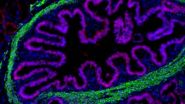(Press-News.org) BETHESDA, MD – Breaking down complex conditions such as Type 2 Diabetes and obesity into the specific metabolic proteins and processes that underlie them offers a new approach to studying the genetics of these diseases and how they are interrelated, according to research presented today at the American Society of Human Genetics (ASHG) 2014 Annual Meeting in San Diego.
By studying specific proteins that contribute to such conditions – and the genes that encode them – scientists can develop new drugs that directly target the metabolic processes that do not function properly, explained lead author Jennifer E. Below, PhD, of The University of Texas Health Science Center at Houston (UTHealth) School of Public Health.
"In fact, genes that affect the same process at the protein level can end up influencing multiple traits in tandem," said Dr. Below. Working with colleagues at the Baylor College of Medicine, Harvard Medical School, and the University of Chicago, Dr. Below found that genes that regulate a person's circadian cycle affect quality of sleep but could also put him or her at risk for diabetes. Similarly, the researchers learned, a group of related proteins involved in immune system functions and interactions between cells also plays a role in heart health.
"Findings such as this highlight the importance of capturing the array of effects of genes, rather than treating each analysis as independent. Traits don't exist in silos; they are richly connected and interacting, and we benefit by acknowledging this in our genetic analyses," Dr. Below said.
The researchers have focused their efforts in Starr County, Texas, a community where trends in obesity and Type 2 Diabetes rates have steadily remained about 30 years ahead of the rest of the country. They have sequenced the genomes of more than 1,400 people in Starr County, studying relationships among many traits that affect obesity and diabetes, such as weight, sleep patterns, heart health, eye health, immune function, fat levels, and blood pressure. This allows them to tease apart the roles of lifestyle and environmental factors, including how these traits may affect one another.
"Rates of obesity and diabetes have been increasing at an alarming pace in recent decades," Dr. Below said. "While we know that the genes present in Starr County haven't changed over that period, genetics still presents the best opportunity to study what's happening. By breaking these conditions down into detailed traits and genetic sequence data, we could inform potential treatments," she explained.
In the future, Dr. Below and colleagues plan to study families in order to analyze rare genetic variants that may be present in larger numbers than in the general population, some of which may have a major effect on disease.
"The community has been extremely supportive of our research, which will give us the ability to follow up with families to study the health effects of these rare, large-effect genetic mutations across time and generations," she said.
Other planned work includes analyzing the effects of rare genetic variants on metabolic processes beyond those known to affect obesity and diabetes, within families as well as in the broader population of Starr County. For example, the researchers have taken a detailed look at the proteins and processes involved in eye diseases such as retinal cardiomyopathy, which they plan to expand upon with a focus on family analyses and patterns of inheritance.
INFORMATION:
Press Availability: Dr. Below and Craig L. Hanis, both of UTHealth, will be available to discuss this research with interested media on Monday, October 20, 2014, from 2:00-3:00 p.m., in the ASHG 2014 Press Office (Room 22).
Reference: Below JE et al. (2014 Oct 19).
Abstract: Genome wide association and exome sequence data analysis for more than 100 traits in Mexican Americans. Presented at American Society of Human Genetics 2014 Annual Meeting. San Diego, Calif.
Improving household electricity access in India over the last 30 years contributed only marginally to the nation's total carbon emissions growth during that time, according to a new study published in the journal Nature Climate Change.
"Energy access is fundamental to development: it brings improvements to all aspects of life, including education, communication, and health," says IIASA researcher Shonali Pachauri, who conducted the study.
While increased energy access is widely agreed to be an important goal for development efforts, such as the UN Sustainable Energy ...
VIDEO:
Michael Helmrath, M.D., M.S., surgical director of the Intestinal Rehabilitation Program at Cincinnati Children's Hospital Medical Center, talks about researchers successfully growing human intestinal tissue in mice. The study describes...
Click here for more information.
CINCINNATI --Researchers have successfully transplanted "organoids" of functioning human intestinal tissue grown from pluripotent stem cells in a lab dish into mice – creating an unprecedented ...
DNA has garnered attention for its potential as a programmable material platform that could spawn entire new and revolutionary nanodevices in computer science, microscopy, biology, and more. Researchers have been working to master the ability to coax DNA molecules to self assemble into the precise shapes and sizes needed in order to fully realize these nanotechnology dreams.
For the last 20 years, scientists have tried to design large DNA crystals with precisely prescribed depth and complex features – a design quest just fulfilled by a team at Harvard's Wyss Institute ...
AMHERST, Mass. ¬– The claim by microbiologist Derek Lovley and colleagues at the University of Massachusetts Amherst that the microbe Geobacter produces tiny electrical wires, called microbial nanowires, has been mired in controversy for a decade, but the researchers say a new collaborative study provides stronger evidence than ever to support their claims.
UMass Amherst physicists working with Lovley and colleagues report in the current issue of Nature Nanotechnology that they've used a new imaging technique, electrostatic force microscopy (EFM), to resolve ...
Berlin, 19th October 2014 What's in a name? Doctors have found that the name of the drug you are prescribed significantly influences how the patient sees the treatment. Now in a significant shift, the world's major psychiatry organisations are proposing to completely change the terminology of the drugs used in mental disorders shifting it from symptom based (e.g. antidepressant, antipsychotic etc.) to pharmacologically based (e.g. focusing on pharmacological target (serotonin, dopamine etc.) and the relevant mode of action). This will mean that patient will no longer have ...
Scientists at The University of Manchester hope a major breakthrough could lead to more effective methods for detoxifying dangerous pollutants like PCBs and dioxins. The result is a culmination of 15 years of research and has been published in Nature. It details how certain organisms manage to lower the toxicity of pollutants.
The team at the Manchester Institute of Biotechnology were investigating how some natural organisms manage to lower the level of toxicity and shorten the life span of several notorious pollutants.
Professor David Leys explains the research: ...
Kansas City, MO - While megakaryocytes are best known for producing platelets that heal wounds, these "mega" cells found in bone marrow also play a critical role in regulating stem cells according to new research from the Stowers Institute for Medical Research. In fact, hematopoietic stem cells differentiate to generate megakaryocytes in bone marrow. The Stowers study is the first to show that hematopoietic stem cells (the parent cells) can be directly controlled by their own progeny (megakaryocytes).
The findings from the lab Stowers Investigator Linheng Li, Ph.D., described ...
At least 2 percent of people over age 40 and 5 percent of people over 70 have mutations linked to leukemia and lymphoma in their blood cells, according to new research at Washington University School of Medicine in St. Louis.
Mutations in the body's cells randomly accumulate as part of the aging process, and most are harmless. For some people, genetic changes in blood cells can develop in genes that play roles in initiating leukemia and lymphoma even though such people don't have the blood cancers, the scientists report Oct. 19 in Nature Medicine.
The findings, based ...
CHICAGO – Oct. 19, 2014 – The first tear duct implant developed to treat inflammation and pain following cataract surgery has been shown to be a reliable alternative to medicated eye drops, which are the current standard of care, according to a study presented today at AAO 2014, the 118th annual meeting of the American Academy of Ophthalmology. The device, known as a punctum plug, automatically delivers the correct amount of postoperative medication in patients, potentially solving the issue of poor compliance with self-administering eye drops.
After cataract ...
BETHESDA, MD – A child's genetic makeup may contribute to his or her mother's risk of rheumatoid arthritis, possibly explaining why women are at higher risk of developing the disease than men. This research will be presented Tuesday, October 21, at the American Society of Human Genetics (ASHG) 2014 Annual Meeting in San Diego.
Rheumatoid arthritis, a painful inflammatory condition that primarily affects the joints, has been tied to a variety of genetic and environmental factors, including lifestyle factors and previous infections. Women are three times more likely ...




